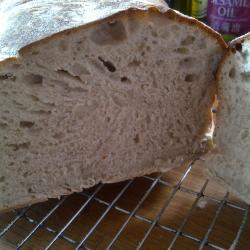
Today I attempted to make a large braided loaf!
I'm not sure weather it was because when I went to put it into the oven I discovered I'd left a roasting tin on the top shelf. This caused me to put the loaf on the lower shelf and I think it might have expanded into the top shelf and then oozed out the side. That being said, the braid didn't really show in the finished loaf?
I wonder whether it's just the wrong shape for a sour dough loaf really?
The thing is I am trying to make a sandwiches for work friendly kind of loaf and I find that sour dough has a tendency to 'spread' somewhat.
I also find that in a loaf tin my bread tends to me quite flat topped. Which is fine, it's just not the loaf I'm looking for.
I wonder if anyone out there has any ideas to help me achieve my goal, or any thoughts on today's shaping mishap? All input is much appreciated.
Here's my recipe, again it's adapted from Richard Bartinet's book 'Crust'
300g of 100% Hydration starter
900g of Strong white bread flour
100g Rye flour
20g salt
I proved this overnight in the fridge for about 16 hours Then bought out to come to room temperature and to shape for about another 2 hours before going into the oven.

However as you can see from the next picture, this isn't a total disaster as the crumb is good and it is a 'sandwich freindly' size, even if it is a little uneaven.


Replies
I am no expert, and it is my first time commenting here, but that is a huge amount of flour for one loaf. I started almost two years ago making a white sourdough loaf for sandwiches that started off as rustic loaves proofed in bannetons. The recipe was posted by "northwestsourdough", maybe on this site, maybe on another popular sourdough site, I'm not sure. Anyway, it uses slightly less overall flour than your recipe, but it makes two loaves. We fell in love with it for sandwich bread, but I eventually decided that that shape was a little difficult to deal with and I decided to try making it in loaf pans. It was a definite success, and I have been doing it this way ever since. I divide the dough into two loaves and plop it into two 9X5 loaf pans before putting it in the fridge overnight. In the morning, I preheat my oven to 450 degrees with the bread stone for about 45 minutes, and then with a roasting pan for 10 minutes (as the recipe calls for). I slash the dough, then I bake the two loaves under the roaster, on the bread stone, for 15 minutes, remove the roaster and bake for another 20 minutes, turning the loaves at 10 minutes. I get enormous oven spring, and the loaves are perfect for sandwiches. Another advantage is that I can fit the two loaves under the roaster and cook at once, which I can't do with the bread proofed in the bannetons. I sort of miss the rustic shape and do make other rustic breads, but this is my "go to" sandwich loaf. I hope this helps. It's worth a try!
Your right of course, the recipe was for two loaves but i kinda though 'what the hey'. I guess bigger isn't always better!
I'm definately going to try your method of proving the bread in the fridge in tins. It seem's just from some quick internet scans that braided loaves tend to be made with recipes involving butter or milk or some such. Maybe that helps to keep the shape?
Hey you tried and that's what counts. What does the bread taste like? I found a video on your tube for you to review about shaping your loaves. It's not about a braid, just simple shaping... http://www.youtube.com/watch?v=45z18TtFijU This other video shows you how to braid bread. http://www.youtube.com/watch?v=R8K6SHj43lY&feature=autoplay&list=PLAA7A4... tube has a lot of videos regarding the many phases in bread that is worth watching, if you can. Make sure your bread tins are large enough, for the amount of bread you are using, and proofing in the fridge is a really good idea. Take careI would start with the dough half to a third filling the loaf tin.
Prove until loaf is about 80% of the size you want or fully proved.
Adjust amount of dough (next timr you bake) until you get a result you are happy with.
If you want an open texture you will have to be a lot gentler than the woman in the video.